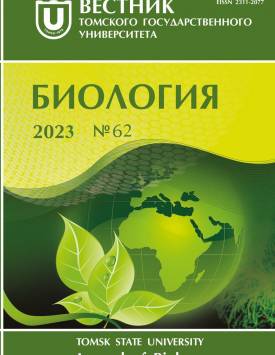The Infestation of Snails of the Genus Bithynia with Cercariae of the Trematodes of the Family Opisthorchiidae in Water Bodies of the Ob River Basin (Tomsk Oblast, Russia)
Gastropods of the family Bithyniidae are common inhabitants of freshwater reservoirs of Western Siberia. They make up to 16% of the biomass of gastropods in the ecosystems of the south of Western Siberia. In Bithynid snails from the water bodies of this region, 33 species of parthenite trematodes of 15 families were found, of which the greatest medical importance is established in the parasites of the hepatobiliary system of the trematode of the Opisthorchiidae family. The liver fluke Opisthorchis felineus (Rivolta, 1884) is the causative agent of a dangerous zooanthroponosis - opisthorchiasis. In Western Siberia, in the basins of the Ob and Irtysh rivers, there is a powerful natural focus of opisthorchiasis. The study of the first intermediate hosts and their infestation with O. felineus cercariae is a necessary component in the assessment of the epidemiological situation and in the prevention of opisthorchiasis. It is important to understand the dynamics of opisthorchia infestation of the first intermediate hosts and to analyse the factors influencing their infestation. This work is aimed to study the infection of gastropods of the family Bithyniidae with opisthorchid cercariae, and especially Opisthorchis felineus in the middle Ob basin. The material for the study was collected along the banks of floodplain lakes and the channel of the Ob River basin. For two seasons of 2021-2022, snails of the genus Bithynia (2987 specimens) of two species B. troshelii (Paasch, 1842) (1558 specimens), B. tentaculata (Linnaeus, 1758) (1429 specimens) were collected. Detection and separation of cercariae was carried out by compression, using light microscopy, isolated cercariae were fixed in 70% ethanol to clarify their systematic status. Cercariae were identified by morphological features. Morphological identification of cercariae of the family Opisthorchiidae was confirmed by molecular genetic methods - PCR diagnostics based on a genetic marker. As a result of our research, two species of snails of the genus Bithynia (B. tentaculata and B. troschelii) were identified, their average abundance was 60.1 ind. m-2. In general, no differences in the number of two species of snails in water bodies were found during the period of research. Trematode cercariae were found in 108 snails specimens; only 17 snails contained O. felineus. The general extensiveness of the invasion of snails of the genus Bithynia by trematode cercariae accounted for 3.62%, B. tentaculata - 3.98%, and B. troschelii - 3.27%. Extensiveness of invasion in the two species of snails in general in water bodies varies significantly, as well as the observed differences in the level of infection over the years of observation (Fisher test, p < 0.05). Extensiveness of invasion of snails B. troschelii by cercariae O. felineus was 1.09% as a whole, varying in different reservoirs. The most infected with O. felineus were snails from flowing water bodies (rivers, channels), less infected in lakes that do not have an annual connection with the river, and not infected in continental lakes (Fisher test, p < 0.05). The study of the seasonal dynamics of infection of snails showed that in samples from May to mid-June, no infected snails were noted in any of the studied water bodies, snails with cercariae were noted only from the second half of June and in July. Thus, the snails Bithynia troschelii, which are the first intermediate hosts of the trematodes Opisthorchis felineus, live in the basin of the middle Ob. The number of snails varies from 3 to 110 ind. m-2 depending on the reservoir. In general, the prevalence of invasion of snails by O. felineus cercariae is low, in different water bodies it varies from 0% to 14.3%. Infestation depends on the type of reservoir, season, and year of observation. The article contains 3 Figures, 2 Tables, 26 References.
Keywords
Bithyniidae, Opisthorchis felineus, cercariae, abundance, extensiveness of invasionAuthors
| Name | Organization | |
| Simakova Anastasia V. | Tomsk State University | omikronlab@yandex.ru |
| Babkina Irina B. | Tomsk State University | bibsphera@gmail.com |
| Katokhin Alexey V. | Federal Research Center Institute of Cytology and Genetics, Siberian Branch of the Russian Academy of Sciences | katokhin@bionet.nsc.ru |
| Babkin Alexander M. | Tomsk State University | babkin.alex1983@gmail.com |
| Interesova Elena A. | Tomsk State University; Novosibirsk Branch of Russian Federal Research Institute of Fisheries and Oceanography ("ZapSibNIRO") | interesovaea@yandex.ru |
| Mrakina Ekaterina V. | Tomsk State University | katerinamrakina@gmail.com |
References

The Infestation of Snails of the Genus Bithynia with Cercariae of the Trematodes of the Family Opisthorchiidae in Water Bodies of the Ob River Basin (Tomsk Oblast, Russia) | Vestnik Tomskogo gosudarstvennogo universiteta. Biologiya - Tomsk State University Journal of Biology. 2023. № 62. DOI: 10.17223/19988591/62/4
